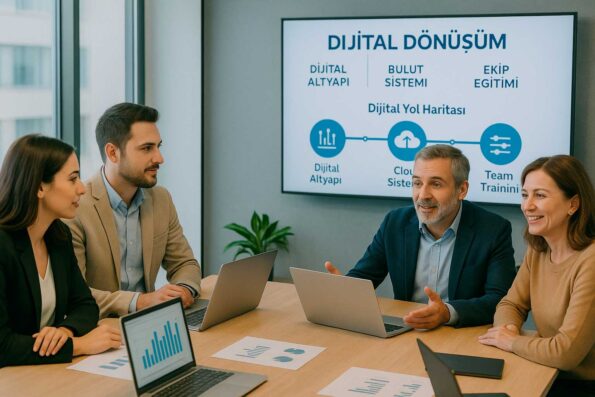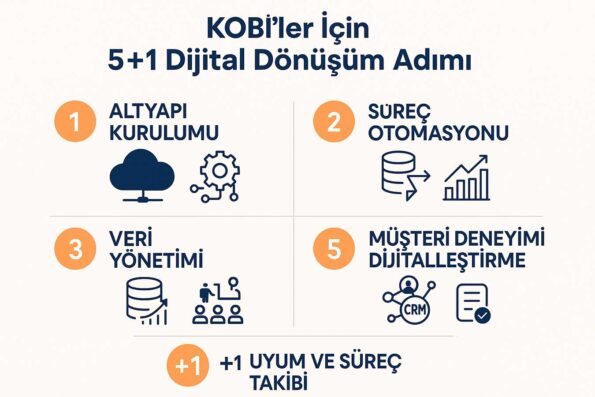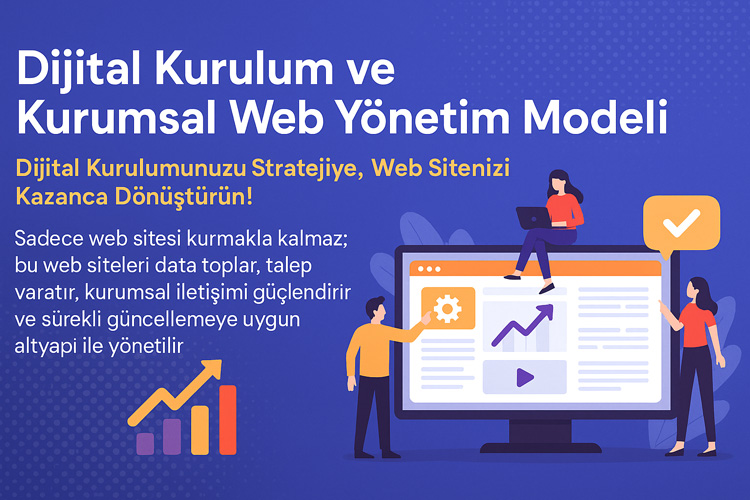“Thanks to digital transformation, SMEs can not only keep up with the competition; they can also make a strong leap forward in growth, efficiency, and sustainability.” For small and medium-sized enterprises (SMEs), digital transformation is no longer a choice; it is a prerequisite for existence. Changing customer habits, agile competitors, and the competitive advantage brought by automation are bringing SMEs to a decision point: adapt or perish. The most frequently asked question at this point is: “So where do we start?”
The process of initiating a Digital Transformation for SMEs is often characterized by anxiety, limited resources, and uncertainty. However, with the right strategy, a well-defined roadmap, and sustainable goals, this journey can be much more productive than expected. The 5+1 Digital Adaptation Plan™, developed by Adapte Dijital, offers a clear and actionable model specifically for SMEs in this regard.
In this comprehensive guide, we will share a measurable and strategic plan that can be customized to the sector, scale, and current structure for any SME that wants to take the step towards digital transformation. 📊 Each step is designed to be data-driven and open to measurement, providing both confidence for managers and clarity for teams.
İçindekiler
ToggleBefore Starting Digital Transformation: The Awareness Process for SMEs
Every digitalization story begins with a moment of awareness. This could be declining sales, inefficient operations, or the struggles of a brand that is not visible digitally. At this stage, SMEs are searching for a clear answer to the question, “Should we go digital?” However, the real question is: “If we don’t start going digital today, what price will we pay in a year?”
👉 Initial awareness often comes from external triggers: competitors switching to e-commerce, customers’ online demands, or business partners demanding digital tools. An internal assessment should be conducted at this stage:
- What is the current infrastructure like?
- Which business processes are being handled manually?
- Which steps are wasting time and resources?
📌 This awareness step forms the basis of strategic planning. Not a blind transformation is required, but measurable adaptation. And that’s where the 5+1 model comes into play.
What is a 5+1 Compatible Roadmap for Digital Transformation?
The 5+1 Digital Adaptation Plan™, developed for SMEs’ Digital Transformation, is a holistic approach that, unlike traditional SME Digital Transformation models, takes into account both the internal resources and external dynamics of the business.

The 5 steps of this model form the framework of the transformation, while the “+1” step ensures sustainability.
💡 To summarize briefly:
- Digital Asset Identification
- Process Digitization
- Integration and Automation
- Team and Cultural Adaptation
- Measurement and Reporting
+1. Strategic Management and Sustainment
>
Digital Asset Assessment: Where Are You and How Ready Are You?
The first step in a solid start for SMEs’ Digital Transformation is to clearly identify their existing digital assets. Many SMEs make transformation plans without being aware of the tools or digital processes they currently use. However, the path to success is knowing where you start.
A good digital asset assessment is a process that provides an overview of the current status of digital components such as the website, social media accounts, customer data, ERP/CRM software, and cloud systems.It starts with analysis. 🧩 Which systems are integrated? Which ones are just for show? Which ones are the most time-consuming or the most efficient? The answers to these questions form the backbone of your planning.
Website and Digital Visibility
For many SMEs, a website is simply a storefront. But now, this storefront is the first point of contact with the customer. Is your website mobile-friendly? Does it have SEO infrastructure? Is your page speed competitive? Your answers to these questions determine the quality of your digital journey.
Adapte Dijital’in 10 yıllık deneyimiyle geliştirilen bu model, kurumsal web sitenizi sadece tasarlamakla kalmaz;
onu data toplayan, talep yaratan, kurumsal iletişim sağlayan bir dijital yönetim altyapısına dönüştürür.
Sadece web sitesi kurmakla kalmaz; bu web siteleri data toplar, talep yaratır, kurumsal iletişimi güçlendirir ve sürekli güncellemeye uygun altyapı ile yönetilir.
Social Media and Brand Representation
Having social media accounts doesn’t mean they’re actively and strategically managed. Elements such as content frequency, visual consistency, and follower engagement reflect the perceptual power of your brand. For SMEs, this channel is also a customer support channel. 📲
Customer Data and Communication Infrastructure
How organized is your current customer data? Do you have a CRM infrastructure, or is it kept in Excel? Details like these form the foundation of building sustainable relationships with customers. In digital transformation, data is as precious as gold.
The Effectiveness of Existing Digital Tools
Are the tools you use truly useful, or are they just being used for the sake of it? The performance of systems like cloud storage, task management software, and email automation should be measured. 💻 Inefficient tools waste both time and budget.
Process Digitization: How to Automate Your Operations
The next step in SME Digital Transformation is transforming business processes with technology. Especially for SMEs, time loss, human error, and manual processes are the biggest obstacles to growth. Process digitization is used to eliminate these obstacles.
Many business processes, such as inventory management, order tracking, accounting, human resources, and customer relations, can be streamlined with appropriate software and automation tools. 📊 The key is to choose the right tool for each process and integrate it into the existing workflow.
Automation of Repetitive Tasks
Repetitive operations are often the most time-consuming tasks in SMEs. Tasks like invoice issuance, payroll preparation, and inventory entry can be completed in seconds with digital tools. This way, the team can focus on more strategic tasks.
Digitalizing Customer Processes with CRM Systems
Customer relationship management is a critical process for SMEs. Thanks to CRM (Customer Relationship Management) systems, customer information is collected in a single location, the sales process is digitized, and the customer experience is improved. 🌐 These systems also provide a strong foundation for after-sales support.
Integrated Process Management with ERP
ERP (Enterprise Resource Planning) systems connect all processes, from production to human resources. Especially for growing SMEs, ERP offers the opportunity to grow without losing control. By gathering all data on a single platform, management decisions become easier.
Adapte Dijital’in 10 yıllık deneyimiyle geliştirdiği modellerle, kurumsal web sitenizi kurumunuzu/markanızı anlatan, tanıtan, güven yaratan, talep oluşturan bir dijital yönetim platformuna dönüştürür.
Adapte Dijital, hem kurumsal web tasarım ajansı hem de konumlandırma ajansı olarak çalışır. Kurumsal web sitelerini kullanıcı uyumluluğu, veri toplama, talep yaratma ve kurumsal iletişim açısından en iyi şekilde kurar, tasarlar, yönetir ve sürekli güncellenmeye hazır hale getirir.
Task Management and Tracking Tools
Digital task management tools provide a significant advantage for teams working on projects and tasks. Tools like Asana, Trello, and Monday.com strengthen communication within teams, track deadlines, and increase productivity. 🚀 These types of tools play a critical role, especially in remote teams.
Choosing the Digital Infrastructure: The Right Technology, the Right Time, the Right Team
One of the most important milestones in an SME’s digitalization journey is choosing the right digital infrastructure. Because the technologies used directly impact not only today but also the growth potential in the coming years.
Wrong choices in infrastructure selection can lead to software incompatibilities, high costs, or inefficiency within the team. Therefore, before investing in infrastructure, SMEs should conduct a needs analysis, choose scalable systems, and prepare the human resources to handle the technology. 🔧
Digital Transformation vs. Digital Installation: Which One is Right for You? We recommend reviewing our article.
Advantages of Cloud-Based Systems
Cloud-based solutions for SMEs’ Digital Transformation offer both low investment costs and rapid integration. No server investment is required, allowing access from anywhere. Additionally, the risk of data loss is low, and system updates are automatic.
Integration Compatibility: Systems Working Together
For a digital infrastructure to be effective, all components must be compatible with each other. For example, your CRM system, e-commerce infrastructure, and ERP must be able to share data with each other. API-enabled solutions stand out in this regard. 🔄
Cybersecurity Priority
The security of the chosen infrastructure is vital for data protection. SMEs are often the weak link in this regard. However, a secure digital infrastructure can be established with measures such as SSL certificates, multi-factor authentication, and regular backups.
Team Alignment and Training Support
Even the best infrastructure is useless if it’s not used correctly. Therefore, when selecting an infrastructure, not only software but also team training and ease of use should be considered. User-friendly interfaces and guided migration processes are of paramount importance. 📘
Establishing a Digital Communication Strategy with Internal and External Stakeholders
SMEs must transform not only their internal processes but also stakeholder communication during their Digital Transformation journey. Because the true impact of digitalization is felt across the entire communication chain, from suppliers to customers, employees to investors.
Instant messaging, task management, and shareable cloud systems are at the forefront of internal communication, while customer experience, social media management, and automated response systems are decisive in external communication. Therefore, the communication strategy should be informed not only by the tools but also by the organizational culture. 🤝
Determining Internal Team Digital Communication Channels
Tools like Slack and Microsoft Teams facilitate communication within teams. Transparently distributing tasks, conducting online meetings, and centralizing information sharing accelerate workflow.
Digitalizing the Customer Experience
The way SMEs reach their customers has changed. Thanks to live chat systems, social media support bots, and automated email responses, customer requests can be met instantly. This directly impacts satisfaction and loyalty. 😊
Synchronized Digital Infrastructure with Suppliers
Digitally sharing information with suppliers, such as order management, invoice tracking, and stock status, saves time and reduces error rates. This synchronization with ERP or B2B systems supply chain Increases efficiency.
Data Privacy in Communication Strategy
Data security is a key priority in digital communication. It is imperative for SMEs to comply with legal regulations such as KVKK and GDPR to gain the trust of their customers and business partners. 🔐
Performance Tracking and Digital Success Indicators
The digitalization process isn’t completed simply by installing systems; true success is achieved through measurable and sustainable performance management. For SMEs, the true indicator of success in digital transformation is the numerical analysis of processes and decision-making based on this data. At this point, “digital KPIs” become the business’s compass. 📊
Each business should define specific performance indicators based on its sector, goals, and stage of digitalization. These indicators should not only include web traffic or sales figures, but also multidimensional indicators such as process speed, customer satisfaction, and team productivity.
KPI (Key Performance Indicator) Determination Process
The first step is to define what counts as success. For example, a critical KPI might be a reduced cart abandonment rate for an e-commerce SME, or a shorter delivery time for a manufacturing company. KPIs should be measurable, achievable, and trackable over time.
Using Digital Dashboards
Dashboards, where you can see all digital data on a single screen, accelerate the decision-making process. Web performance, customer behavior, and operational processes can be easily monitored with tools like Google Data Studio and Power BI. 📈
Team-Based Performance Indicators
Not only systems but also the digital performance of human resources should be measured. Metrics such as task completion rate, turnaround time, and training completion percentage can be used to monitor team productivity and streamline feedback processes.
Periodical Reporting and Action Plan
Weekly, monthly, or quarterly reports are used to monitor areas where progress has been made. Improvement actions are determined for areas where there are shortcomings. the digitalization process is dynamic and adaptable🔄
Creating and Sustaining a Digital Compliance Culture
For SMEs to achieve sustainable digital transformation, not only the technical infrastructure but also the transformation of the corporate culture is essential. This culture encompasses fundamental behaviors such as openness to change, a desire to learn, and being comfortable with technology. Unfortunately, many businesses fail to transform because they fail to create a culture of compliance despite investing in technology. 🔄
A digital compliance culture is a structure that not only the management team but the entire team must build together. Employees need to trust digital tools, believe they can be productive with them, and be motivated for continuous improvement. Therefore, cultural transformation requires much more time and strategy than technical transformation.
Initiating Culture with Leadership
Senior management should not only be an investor in the digitalization journey, but also a champion. Leaders motivating their teams with discourses supporting digital adaptation ensures the internalization of the transformation.
Making Training Continuous
To ensure sustainable success in their digital transformation journey, SMEs should view their training processes not as a one-time event but as a continuous development area. Rapid change in digital technologies necessitates regularly updating internal knowledge levels. Therefore, employees need to not only learn new software or systems but also embrace a digital culture. Training should focus not only on technical skills but also on problem-solving, digital literacy, and data-thinking skills.
SMEs should develop modular and repeatable training content during the digital transformation process to ensure that every team member adapts to the process. Distance learning platforms, video academies, and microlearning modules are highly effective in this process. Furthermore, the success of training should be measured with digital KPIs; participation, learning levels, and implementation rates should be tracked. By making training continuous throughout their digital transformation processes, SMEs achieve not only a technological but also a cultural transformation. This, in turn, increases both internal efficiency and external competitiveness in the long run. 💡 📚
Establishing Participation and Feedback Mechanisms
Actively collecting employees’ experiences and feedback on digital tools both accelerates adoption and increases motivation. This way, user-centered improvements can be made.
Making Success Visible
Sharing good examples within the organization and announcing the tangible outcomes of digital transformation is crucial. This encourages other teams to participate in the change. 🏆SMEs can strengthen trust by sharing the successes they achieve during the digital transformation process not only with internal teams but also with customers and business partners. The time, cost, and quality advantages achieved through digitalization can be concretely demonstrated through data reports, infographics, and digital content. SMEs can strengthen their position in the industry by making every strategic step they take in their digital transformation journey visible. This visibility provides long-term benefits in terms of both new customer acquisition and brand value. Through digital transformation, SMEs not only measure internal success but also their external competitiveness.
Barriers to Digital Setup and How to Overcome Them?
While digital setup is considered an easily understandable process in theory, SMEs face various challenges during the implementation phase of Digital Transformation. These challenges are not only technical but often psychological, managerial, andIt’s related to resistance and lack of awareness at the organizational level. Especially for businesses with limited resources, these obstacles can cause the digitalization journey to be delayed or abandoned altogether.
However, it’s possible to manage the digital installation process with a step-by-step roadmap that proactively identifies obstacles. In this section, we’ll detail the most common obstacles to the digital installation process and, with examples, how to overcome them. 🚧
Resisting Change
Digital Transformation in SMEs is not a software transformation, but a mindset transformation. This transformation requires changing not only the technological infrastructure of the business but also its culture. Resistance to change, one of the most common obstacles in SMEs, is often fueled by employees’ fear that their work habits will change and their habits will be disrupted.
📌 What could be a solution?
- Clear communication: Before starting the digital installation process, all employees should be clearly informed about the reasons for this process.
- Inclusion: Employees should be included in the process at an early stage, increasing their sense of ownership.
- Small wins: Resistance should be broken down over time by demonstrating measurable, tangible benefits at the end of each phase.
Example: An accounting employee might be happy with manual invoice processing. However, once they’re shown how an automated invoicing system will save time and reduce error rates, resistance will give way to acceptance. 💡
How to Build Digital Infrastructure? Check out our Step-by-Step Implementation Guide (2025).
Inadequate Budget and Resource Planning
Many businesses never start the process because they think digital deployment requires large investments. However, the truth is: Digitalization doesn’t always require large budgets; The key is proper planning.
✅ What should be done?
- Prioritization: Not all processes need to be digitized at the same time. You can start with the most critical processes.
- Modular approach: New modules can be added as needed using systems composed of smaller components.
- SME incentives: Support can be obtained from institutions such as TÜBİTAK and KOSGEB.
Thanks to this strategy, the business uses its resources efficiently and minimizes risk. It’s important to remember: Digitalization is not a cost, it’s an investment in the future. 💼

Technology Mix and Incompatibility
One of the biggest technical hurdles is the lack of interoperability between software and hardware from different manufacturers. In this case, systems cannot work in integration with each other and processes become more complex.
🔧 What should be done?
- BCompatible infrastructure selection should be made initially.
- API (Application Programming Interface) supported systems should be preferred.
- If necessary, a system integrator should be worked with.
Technology should be a solution tool; it should not become a source of new problems in and of itself. 🤖
Lack of Training and User Acceptance
Businesses often make the mistake of assuming that once the digital setup is complete, the work is done. However, the real issue isn’t the installation of the system, but rather employees’ effective use of these systems.
🎯 What can be done?
- Stage training should be organized according to user levels.
- Frequently asked questions (FAQ) documents should be prepared.
- Support with video content and screen recordings should be provided.
For a system to be successful, the human resources behind it must also understand and own the process. Without training, there is no productivity. 🎓
In Conclusion
The digital deployment process has a multifaceted structure, including change management, budget planning, technical compliance, and training. However, every obstacle that may be encountered during this process can be turned into an advantage when identified in advance. Leadership, planning, and a strategic approach make all of these obstacles manageable.
At Adapte Digital, we are not only consultants but also companions for SMEs on this journey. 💼🚀
Most Frequently Asked Questions and Answers During the Setup Process
Every SME considering a digital setup process has similar questions. These questions can sometimes delay the process or even cancel it altogether. However, when these questions are answered clearly with accurate information, indecision gives way to clarity and action. In this section, we present the most frequently asked questions and clear answers by businesses on their digital deployment journey:
When SMEs begin their digital transformation process, they frequently ask which software and systems are best suited to their needs. At this point, making choices without identifying solutions aligned with business goals can reduce the efficiency of the process. SMEs frequently ask, “When should ROI be expected?” during digital transformation, and the answer to this question is directly related to process monitoring and performance metrics. SMEs, who are also uncertain about how technical support and maintenance processes will work, should pay special attention to sustainability after the transformation. When SMEs can obtain clear and strategic answers to such critical questions during the digital transformation process, their success rate increases significantly.
What Should I Do Before Beginning the Installation?
The first thing businesses should do before starting the installation process is analyze their current business processes. Because digital installation is not just a choice of technology, but also a reengineering of processes. Technologies purchased without prior analysis will either be a wasted investment or will not increase productivity.
✅ What needs to be done:
- Process maps should be created
- Every department on the team should be involved in the process
- Digitalization targets aligned with business goals should be clarified.li
This step can eliminate 70% of future problems. 📊
What Kind of Technologies Should I Invest In?
The answer to this question varies depending on the size of the business, its industry, and its digitalization goals. However, for small and medium-sized businesses, the following categories are generally critical from the start:
- Data management and analytics systems
- Customer relationship management (CRM)
- Digital marketing tools
- Internal communication and project management platforms
- Cloud-based document sharing and archiving
You should start with a small number of integrated systems and add modules as needed. This way, resources are used efficiently and technology waste is prevented.
How Long Does Installation Take?
Digital installation time varies greatly depending on the scope of the work. While a small CRM system installation can be completed in a few days, comprehensive projects like production tracking and ERP integration can take months.
Average times:
- Simple system installations: 5–15 business days
- Solutions requiring integration: 1–3 months
- Large digital installation projects: 4–6 month
However, the most important point to remember is: Installation is not a one-time process, it’s an ever-evolving cycle. 💡
Will I get support after installation?
The answer to this question should be yes. Because even the best system is not sustainable without user support and maintenance.
Post-installation support should include:
- System training (online/offline)
- Support line for common issues
- Software updates
- Performance analysis and improvement meetings
📌 Adapte Dijital‘s installation services aren’t limited to installation. They also include continuous improvement, measurement, and optimization. Because we know that a successful digital infrastructure becomes meaningful if it’s consistently supported.
How to Plan a Budget for a Digital Installation?
Budget planning is often the most postponed step in digital transformation. For SMEs, the question “How much budget should we allocate?” directly impacts the decision to begin the process. However, a well-planned budget not only keeps costs under control but also revenue. Uncontrolled or incomplete planning of digital infrastructure spending leads to wasted time and money. So, how should a budget be planned for a digital installation?
What is Digital Installation? Where Should You Start in Your Company? We recommend taking a look at our article.
Segment Your Budget Based on Your Needs
Digital installation expenses shouldn’t be considered a “single item.” Because the technologies, modules, and services needed by each business are different, it’s best to divide the budget into segments. For example:
- Infrastructure Expenses: Server, network, software licenses
- Installation and Integration Expenses: Technical team, API services
- Training and Adoption: Team orientation, user training
- Support and Maintenance Services: Updates, technical support
Allocating a separate portion for each segment makes the total budget visible and reduces unnecessary costs. 💰
Distinguish Between Fixed and Variable Expenses
In the digital setup process, some costs are one-time (fixed), while others are ongoing (variable). Knowing this difference is crucial for long-term planning.
- Fixed costs: Hardware purchases, initial setup services
- Variable costs: Cloud services, subscription-based software, support packages
Example: A cloud service costing 6000 TL per year should be included in the budget for system sustainability. Not only the initial investment but also the needs of the “living system” should be considered.
Build Your Budget Plan According to Your Goals
The installation budget is not just an investment in technology, but also in the goal. In other words, “What will this system gain me?” A budget should not be created without answering this question.
Sample goals:
- Speed up sales processes by 30%
- Increase customer satisfaction by 20%
- Reduce errors in inventory tracking
The budget allocated for each goal should be return on investment (ROI) This way, planning is focused on profits, not just costs. 📈
Minimize Risks with Phased Installation
Installing the entire system at once can mean significant risk and cost. Therefore, phased installation is the most effective approach, especially for SMEs. For example:
- Phase: CRM system installation and user training
- Phase: Sales integration with ERP
- Phase: Automatic reporting modules and KPI tracking
This model allows you to spread the budget over time, and measure the success of each phase to determine the next step. This means “step by step success.” 🧩

How to Measure the Success of an Installation? Digital KPIs and Performance Indicators
What should SMEs do to measure success in the digital transformation process?KPIs must be defined. As part of their digital transformation plans, SMEs should closely monitor performance indicators such as increased sales volume, customer satisfaction scores, and accelerated business processes. The true functionality of established systems becomes evident within the first 3–6 months of an SME’s digital transformation journey. The time savings and reduced human error afforded by automation, in particular, can demonstrate the impact of SME digital transformation investments even in the short term. Therefore, SMEs should evaluate their digital transformation processes not only with the installation itself, but also with the value this installation provides.
Read our article: Why is Digitalization Important? 5 Critical Reasons for SMEs.
Why Are KPIs Important?
KPIs allow you to monitor the performance of your systems after installation. Without these indicators, you can’t have an idea of the effectiveness, efficiency, or return of your installed system. For example:
- Has traffic to your website increased?
- Has sales conversion rates increased?
- Has stock outages decreased?
- Has customer complaints decreased?
Every Each is a KPI and directly measures the success of the digital system. 📊
Which KPIs Should You Track?
The indicators to track may vary depending on your business model. But fundamentally, these are the digital KPIs that every SMB should monitor closely:
- Digital Sales Conversion Rate (%): How many visitors converted to sales?
- Cost per Visitor (CPA): What is the cost of a customer from a digital ad?
- System User Adoption Rate: How much is the team using the new software?
- Response Times: How quickly do automated systems respond to requests?
- Customer Satisfaction (NPS): How do users feel after the system?
These metrics quantify the true impact of the installation on your business. 📈
How to Track KPIs?
Listing KPIs on paper isn’t enough. For effective tracking, measurement tools must be established and continuous monitoring must be conducted. Some of these tools include:
- Google Analytics / GA4: For website and traffic analysis
- CRM Dashboards: For customer relations and sales KPIs
- ERP Reports: For operational performance and supply management
- Customized KPI Dashboards: For business Specially developed dashboards
This way, the entire team can see the results of the implementation in numbers. 🧮
Strategy Should Be Updated Based on Performance
KPIs are not just tracking tools, they are also guidance tools. If the expected results are not achieved after the digital implementation, intervention in the process is essential.It is necessary to make KPIs tell you this.
For example:
- If the number of visitors is high but sales are low → conversion optimization is needed
- If system usage is low → additional training should be planned
- If stock errors persist → ERP module should be reviewed
KPI data = the compass that shows direction. Digitalization will be sustainable if the strategy is shaped according to this data. 🚀
Why Digital Installations Fail and How to Prevent Them?
The most common reasons for failure in the digital transformation process of SMEs are not defining a clear strategy, lack of communication within the team, inadequate technological infrastructure, and resistance to change. When SMEs launch their digital transformation plans without supporting them with concrete goals, the process can quickly devolve into uncertainty and wasted resources. Furthermore, simply investing in technology isn’t enough; how these investments will be integrated into daily workflows must also be planned from the outset. During digital transformation, SMEs should choose software and hardware based on needs, not budget. Otherwise, resources spent on unnecessary solutions will reduce the transformation’s efficiency.
For success, performance measurement and adaptation strategies must be implemented at every step; SMEs should view the digital transformation process not as a single project but as a constantly evolving structure. Lack of training is one of the biggest obstacles to digital adoption. Therefore, SMEs should not neglect team awareness and competency development programs before embarking on their digital transformation journey. SMEs should adopt a lean, data-driven, and user-friendly approach to internal processes for digital transformation success.
Lack of a Clear Goal
Many businesses fail to clarify their reasons for deciding to go digital. Simply starting with the mindset of “their competitor did it, so let’s do it too” leads to building a system and then abandoning it. However, the following questions must be answered:
- What problem do we want to solve?
- What kind of return do we expect, and how quickly?
- Which teams and processes will we digitize?
🔍 An installation without a goal means an investment without results.
Insufficient Focus on Team Training
Even the best system becomes useless if a team can’t use it properly. Neglecting post-installation training plans can lead to software being perceived as “incomprehensible.” This creates resistance.
Therefore:
- Training should be planned at the beginning of the project,
- Applied and repetitive modules should be preferred,
- Specific content should be developed for each department.
🎯 An untrained team cannot accept a digital system.
The Application Is Not Suitable for Real-Life Processes
Systems that work well only in demo presentations but do not fit real-life processes are quickly abandoned. ERP, CRM, or automation tools need to be customized to fit real-life workflows. Otherwise:
- Staff reverts to manual methods,
- Reporting breaks down,
- The digital structure is fragmented.
🛠️ The installation must be successful in practice, not in theory.
Insufficient Senior Management Support
Decision-makers’ lack of ownership of the process during the installation process negatively impacts the entire organization. When senior management is not actively involved in the process:
- Teams lose motivation,
- Projects are delayed or left unfinished,
- System culture doesn’t take root.
💼 Digitalization is not just the responsibility of IT, but of all management.
Which Experts and Teams Should You Work With for Your Digital Installation Project?
The success of a digital installation project depends not only on the technological infrastructure but also on the right human resources and expert team structure. One of the biggest mistakes SMEs make in this process is focusing solely on software or hardware. leaving it to the provider. However, the installation process requires multifaceted teamwork, including planning, management, technical implementation, and adaptation.
Therefore, SMEs should identify the right experts to run the project and clearly define their responsibilities to ensure the sustainability of the process. So, who should be involved in this process?
Project Manager (Digital Transformation Officer)
The installation process The project manager is the person who monitors, manages, and reports all steps from beginning to end. The project manager must be competent in strategic planning, people management, and scheduling, as well as technical knowledge. Their duties include:
- Create an installation schedule,
- Perform resource planning,
- Ensure coordination between teams,
- Predict and mitigate risks
⏱️ If no one is at the helm of the project, the destination is uncertain.
IT Specialists (Infrastructure and System Integration)
The team that handles the technological leg of the installation. Servers, network infrastructure, cloud solutions, security layers, and software Integrations are carried out by this team. This team, which SMEs often outsource,:
- Conducts technical analysis,
- Performs hardware and software installations,
- Performs system tests and security checks.
🔧 If the infrastructure is not well-established, the system will collapse and the brand will be damaged. sees.
Operations and Process Analysts
Process analysts thoroughly examine the workflows to be migrated to the digital system. Installations without this team often become “off-the-shelf” systems and are useless. The duties of process analysts:
- Analyze existing business processes,
- Make them compatible with the digital system,
- Recommend necessary revisions.
📊 Digitizing the right processes, not just digitizing them, is essential.
Internal Communications and Training Officers
This is one of the most neglected yet critical roles. Providing accurate information to staff who will adapt to the new system increases its acceptance. This team:
- Makes clear, understandable announcements to all employees,
- Prepares and implements training programs,
- Gathers user feedback.
📣 Communication, not technology, is everything.
You’ve Completed the Setup, Now What? The Digital Adoption Process
Completing the digital setup is actually the beginning of the journey. Most SMEs assume that once the infrastructure is in place, things will fall into place automatically. However, for technology to be effective, people need to embrace it. This is where digital adoption comes into play.
The adoption process involves both employees adapting to new systems and the company’s ability to maintain the new digital landscape. A poorly planned adoption process leads to wasted investment and stagnant technological infrastructure. 🚧
Why Is Adaptation Just as Important as Installation?
Installation brings the “hardware” part of the digital system to life; adaptation ensures that this system integrates with user habits. Adaptation process:
- Increases the active usage rate of systems,
- Increases efficiency,
- Prevents errors and resistance.
🎯 Digital transformation is not just about building systems; is to make it work.
Training Programs Tailored to Employees
Uniform training programs are often not sufficient. Specialized training tailored to employees’ areas of responsibility:
- Enables faster learning,
- Reduces bias against the system,
- Facilitates performance monitoring.
📚 It promotes a “provide appropriate training for everyone” approach, rather than a “provide the same training to everyone” approach.
Usage Tracking and Feedback Mechanism
Post-installation usage tracking shows the system’s adoption. In this process:
- Who uses which tool, how much, and how often?
- Which departments still use old methods?
- Which modules have bottlenecks?
These questions should be answered through regular measurement and feedback meetings. 📊
Digital Guidance and Mentoring Process
Especially in small businesses, some employees need more support in the digital transition. A
- Provide ongoing support,
- Answer questions,
- Accelerate the habit-building process.
🤝 People who don’t receive support drift away from the system.
How Do You Measure Success After the Digital Setup Is Completed?
When the digital setup process is complete, many SMEs are left with the question: “Was this investment worthwhile?” To answer this question, a clear success measurement system must be established. Because you can’t manage or improve what you can’t measure. Measuring success both helps you understand the current situation and shapes future strategic decisions. 📈After completing the digital transformation process, SMEs should evaluate success not only by whether the software works, but also by the achieved productivity increase and customer satisfaction. SMEs should regularly measure whether they have achieved the target KPIs set in line with their digital transformation strategies. Metrics such as increased sales, customer acquisition, and reduced operational errors are particularly important indicators of the return on investment in digital transformation for SMEs. At this point, not only technical systems but also the team’s adaptation to new processes should be carefully monitored. SMEs should establish post-digital transformation feedback mechanisms and analyze feedback from both employees and customers. This way, SMEs can see that the steps taken in their digital transformation processes are turning into tangible outcomes and can optimize the process when necessary.
Why Is Measurement So Critical?
When digital systems are established, concrete data is needed to demonstrate the system’s effectiveness. Otherwise, assumptions are made. Measurement:
- Which tools are working,
- Which processes are creating bottlenecks,
- Which departments need the most support.
🔍 Predictions are made without data, decisions are made with data.
Determining Key Performance Indicators (KPIs)
To measure digital success, each company needs to define KPIs based on its own priorities. For example:
- Shortening the sales cycle,
- Reducing customer response time,
- Increasing stock and inventory accuracy,
- Increasing labor productivity rates.
KPIs provide the opportunity to compare the target with the reality. 🚀
Instant Tracking with Automatic Reporting Systems
If the established infrastructure doesn’t produce reports, it doesn’t produce value. Thanks to automated reporting tools:
- In-real-time performance can be monitored,
- Error trends are quickly detected,
- Regular data is provided to senior management.
📊 Decisions have a lasting impact when supported by data.
Periodic Evaluation and Strategy Review
Evaluations conducted after the first 3 months, 6 months, and 1 year after installation are very valuable. The following questions should be asked in these evaluations:
- Did the system deliver the expected performance?
- Has the team gotten used to it, or are there any difficulties?
- Have new needs arisen?
🔄 Digitalization is not a fixed goal; it is a constantly evolving process.
📌 About This Content
This content, “How Do SMEs Start Digital Transformation?” This article, titled “5+1 Compatible Roadmap,” aims to explain in detail where small and medium-sized businesses can start in the digitalization process, what steps they need to take, and what they need to pay attention to. Throughout the article, a structure fully compliant with AEO (Answer Engine Optimization), GEO (Generative Engine Optimization), AIO (AI Integration Optimization), and SEO criteria has been adopted.
🎯 This article is not just a piece of content, but also a practical guide for SMEs trying to decide on digitalization.
Start Digitalization with Adapte Digital
This content was prepared for you by Adapte Dijital, which helps SMEs establish their digital infrastructure and develop sustainable digital transformation strategies.
📹 You can find guide videos, success stories, and practical tutorials on these topics on our YouTube channel.
🔔 Subscribe to our channel: Adapte Dijital YouTube
📞 If you’re wondering “Where should I start?” If you’re wondering,
👉 You can contact us at adaptedijital.com and request a custom Digital Installation Model™ plan.







